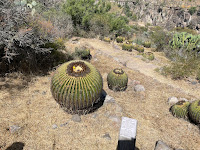I learned so many things from our lovely guide, David Tarrant, during a 2 hour tour at Charco Del Ingenio!
Charco Del Ingenio is a botanical garden and nature reserve. (See Looking back on 2023, Charco del Ingenio) David is a volunteer there, who is 82 years old, and very good at teaching people.
Pictures
1) This is the nopales cactus, also called prickly pear. The wide, flat cactus pads (nopales) are used in many Mexican dishes and as a medicinal plant. The prickly pear fruit, called "atun" (tuna) in Spanish, is very sweet and can be eaten raw, right off the plant. Unlike other fruits, a green prickly pear does not mean that it's unripe.The fruit is at its best when it's very plump, rotund, heavy for its size, with a perfectly smooth skin. In this picture, David is showing us how you can use leaves as a glove, to pick the fruit and rub off the prickly part.

3&4) The scalloped v shape pattern on these agave leaves are created when the leaves are new and tightly packed. The inside of the leaves are fibrous. These fibres, called sisal, can be used for all sorts of things, like rope, carpets, and paper. If you keep the very pointy end of the leaf attached to a fibre, it can be used like a needle and thread!
5) The white dot on this prickly pear cactus pad is the wax coating of a red soft shelled insect called cochineal, from which a natural red dye called carmine can be made. The insects produce the carminic acid to deter predators. Humans can make the dye by brushing the insect off the cactus, drying them, and adding aluminium or calcium salts. In the 16th century, during the colonial period, this dye was an important export good, used an a pigment for fabric, paint and food. Today, carmine is primarily used as a colorant in food and in lipstick (E120 or Natural Red 4).
6) The pale v shaped lime on these cacti indicate one year of growth
7) These are desert ferns. They look dry / dead likes this in the dry season. A few hours after rain begins, they open up into lush green ferns
8) This section of the canyon creates a natural amphitheatre. One the first weekend of spring, musicians climb down to the flat area in the rocks to perform. Past performances have included a grand piano!
9) Coyote poop! They seem to really like pooping on the narrow stone walls built in the garden. The poop is full of seeds! Turns out coyotes are omnivores and will eat cactus fruits, mesquite beans, flowers, insects, rodents, lizards, rabbits, birds, and snakes, depending on the season and what's available.
10 & 11) Once the yellow flowers on this barrel cactus wilt, the tart fruit can be eaten and birds use the fluff, which is attached to the seeds.













No comments:
Post a Comment